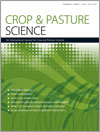To achieve high productivity of labour and water in rice cropping, farmers in South Asia have recently shown more interest in dry direct-seeded rice (DSR). An understanding of physiological and biochemical traits associated with high grain yield and efficiency of nitrogen (N) use is important to the development of genotypes for DSR. We investigated this issue with rice genotypes adapted to DSR in response to N rates. A 2-year study was conducted in a factorial randomised complete block design with eight genotypes and two N rates (75 and 150 kg N ha–1). Almost all of the physiological and biochemical traits studied (e.g. plant height, chlorophyll content, panicle weight, soluble sugars, starch) in DSR improved with increasing N from 75 to 150 kg ha–1, resulting in a 6% increase in yield at 150 kg N ha–1 relative to 75 kg N ha–1. Partial factor productivity of N was highest for the genotype IET-23455 (72.4 kg kg–1) and lowest for the genotype AAUDR (37.4 kg kg–1). Our results suggest that genotypes such as IET-23455 can maintain grain yield at low N rates as N-efficient genotypes. The greater biochemical activity (nitrate reductase and glutamine synthetase, sugar, protein and proline) and higher photosynthetic N-use efficiency at low N rates could be used in selection for N-efficient rice genotypes for DSR.
BioOne.org will be down briefly for maintenance on 14 May 2025 between 18:00-22:00 Pacific Time US. We apologize for any inconvenience.
How to translate text using browser tools
7 October 2016
Physiological and biochemical indicators for assessing nitrogen-use efficiency in rice (Oryza sativa) genotypes under dry direct seeding
Rupinder Kaur,
Seema Bedi,
Gulshan Mahajan,
Gurpreet Kaur,
Bhagirath Singh Chauhan
ACCESS THE FULL ARTICLE

Crop and Pasture Science
Vol. 67 • No. 11
November 2016
Vol. 67 • No. 11
November 2016
Aerobic rice
chlorophyll content
glutamine synthetase
nitrate reductase
proline




